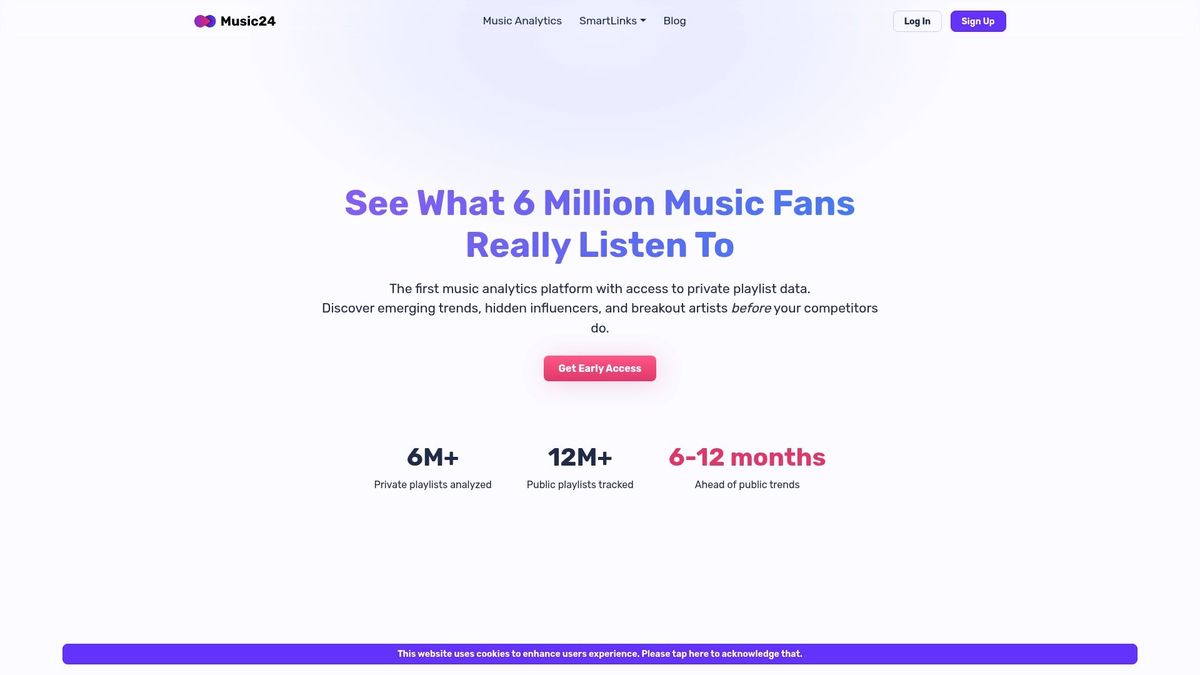Did you know that over 60,000 new songs are uploaded to Spotify every day? With so much music flooding digital platforms, understanding how data shapes the success of artists and tracks has never been more important. Music analytics turns massive amounts of raw musical information into powerful insights about listeners, trends, and industry movement, helping professionals make smarter choices in a rapidly evolving landscape.
Table of Contents
- Defining Music Analytics And Core Concepts
- Key Types Of Music Analytics Explained
- Private Vs. Public Data: Main Distinctions
- How Music Analytics Powers Industry Decisions
- Risks, Limitations, And Ethical Considerations
Key Takeaways
| Point | Details |
|---|---|
| Understanding Music Analytics | Music analytics transforms raw data into strategic intelligence, guiding artist development and marketing efforts through advanced methodologies like metadata analysis and machine learning. |
| Types of Music Analytics | Key categories include streaming, social media, radio airplay, and sales analytics, each providing insights into audience behavior and trends. |
| Private vs. Public Data | Private data offers deeper insights into listener behaviors, while public data provides surface-level information; both have distinct implications for strategic decision-making. |
| Ethical Considerations | Balancing data privacy with the power of analytics is crucial, necessitating transparent practices and respect for individual rights amid growing technological capabilities. |
Defining Music Analytics and Core Concepts
Music analytics represents a sophisticated approach to extracting meaningful insights from musical data, transforming raw information into strategic intelligence for music industry professionals. According to research from multimedia information retrieval disciplines, this field combines advanced technological frameworks to decode complex musical landscapes. Music analytics essentially bridges the gap between raw musical data and actionable strategic knowledge.
At its core, music analytics encompasses multiple sophisticated methodological approaches. Understanding music analytics best practices reveals key frameworks like metadata analysis and algorithmic pattern recognition. These techniques allow professionals to unpack contextual details about recordings, identify emerging trends, and understand listener behaviors across different musical ecosystems.
Multimedia information retrieval (MMIR) provides the technological backbone for music analytics, enabling professionals to extract semantic information from diverse audio sources. The primary methods involve:
- Detailed content summarization
- Advanced audio filtering techniques
- Precise media categorization
- Complex pattern recognition algorithms
Professionals leverage these approaches to decode intricate musical data, transforming abstract information into concrete strategic insights that can drive artist development, marketing strategies, and audience engagement efforts.
Key Types of Music Analytics Explained
Music analytics reveals a complex landscape of specialized analytical approaches that help music industry professionals understand audience behavior, track performance, and make strategic decisions. According to research from Yellowbrick, music analytics encompasses several distinct yet interconnected domains, each offering unique insights into the musical ecosystem.
The primary types of music analytics include streaming analytics, social media analytics, radio airplay analytics, and sales analytics. Understanding the benefits of music analytics provides critical context for how these different analytical approaches work together to create comprehensive market intelligence. These frameworks enable professionals to track listener preferences, measure artist popularity, and identify emerging trends across multiple platforms.
At the technical core of music analytics lies advanced methodological approaches, particularly in areas like music genre classification. According to research, this involves sophisticated techniques including:
- Machine learning algorithms
- Deep learning classification systems
- Advanced music information retrieval techniques
- Sophisticated pattern recognition technologies
These analytical approaches transform raw musical data into actionable strategic insights, allowing music industry professionals to make informed decisions about artist development, marketing strategies, and audience engagement with unprecedented precision and depth.
Private vs. Public Data: Main Distinctions
Private data and public data represent two fundamentally different approaches to music analytics, each offering unique insights and challenges for music industry professionals. While public data is readily accessible and widely shared, private data provides deeper, more nuanced understanding of listener behaviors and preferences that often remain hidden from traditional analytical frameworks.
Understanding the role of metadata in music analytics reveals the critical distinctions between these data types. Public data typically includes openly available streaming numbers, social media interactions, and publicly tracked charts. Private data, conversely, encompasses more intimate datasets like personal playlist compositions, anonymous listening patterns, and detailed user interaction metrics that are not publicly visible.
The significance of private data becomes particularly evident in specialized research domains. For instance, Alternative Measures highlights the importance of symbolic data collection in music studies, demonstrating how private datasets can unlock deeper insights. Key differences between private and public data include:
Here's a comparison of the key differences between public and private music data:
| Aspect | Public Data | Private Data |
|---|---|---|
| Accessibility | Openly available | Restricted, confidential |
| Examples | Streaming charts Social media stats | Playlist compositions User behavior metrics |
| Depth of Insights | Surface-level trends | Detailed, nuanced patterns |
| User Privacy | Minimal risk | High importance |
| Data Granularity | Aggregate metrics | Highly granular details |
| Predictive Potential | Limited | Extensive predictive modeling |
| Ethical Considerations | Transparency | Consent, privacy protection |
- Depth of listener insights
- Level of user privacy protection
- Granularity of behavioral analysis
- Potential for predictive modeling
- Complexity of data collection methods
Music analytics professionals recognize that while public data provides surface-level understanding, private data offers a more intricate and authentic view of musical consumption and listener preferences.
 This nuanced approach allows for more targeted and sophisticated strategic decision-making in artist development, marketing, and audience engagement strategies.
This nuanced approach allows for more targeted and sophisticated strategic decision-making in artist development, marketing, and audience engagement strategies.
How Music Analytics Powers Industry Decisions
Music analytics has transformed decision-making processes across the music industry, providing unprecedented insights that guide strategic choices for artists, labels, and marketers. Industry decision-making now relies heavily on data-driven approaches that go far beyond traditional intuition and historical patterns, enabling more precise and targeted strategies.
Understanding the music analytics workflow for success reveals how complex analytical frameworks translate raw data into actionable intelligence. According to research examining music chart dynamics, comparative analysis of different chart types provides critical insights into track and artist performance trajectories. This allows industry professionals to identify emerging trends, predict potential breakout artists, and develop nuanced marketing approaches.
The technical sophistication of modern music analytics includes advanced classification methodologies that enhance strategic decision-making. Key approaches include:
- Advanced machine learning models
- Two-step classification techniques
- Predictive performance modeling
- Comprehensive track and artist trend analysis
- Dynamic genre classification systems
Professionals leverage these sophisticated analytical tools to make informed decisions about artist development, resource allocation, marketing investments, and audience engagement strategies. By transforming complex datasets into clear, actionable insights, music analytics has become an indispensable strategic resource for navigating the rapidly evolving music ecosystem.
Risks, Limitations, and Ethical Considerations
Music analytics, while powerful, presents a complex landscape of potential risks and ethical challenges that professionals must carefully navigate. Data privacy emerges as a critical concern, with the increasing sophistication of analytical technologies raising significant questions about user consent, information protection, and the boundaries of data utilization.
Understanding music analytics tools in 2025 highlights the nuanced ethical considerations inherent in modern music data collection. According to research on big data in music, the advantages of advanced analytics must be carefully balanced against potential privacy infringements and the risk of algorithmic bias. These challenges are particularly pronounced in areas like genre classification, where diverse musical landscapes create complex categorization problems.
The primary ethical and technical limitations in music analytics include:
- Potential for unintended data privacy breaches
- Risk of algorithmic classification biases
- Challenges in accurately representing musical diversity
- Complexity of obtaining genuine user consent
- Potential for misuse of personal listening data
Music industry professionals must approach analytics with a comprehensive ethical framework, recognizing that technological capabilities must be balanced with respect for individual privacy and cultural musical complexity. This requires ongoing dialogue, transparent data practices, and a commitment to developing analytical tools that prioritize both innovation and individual rights.
Unlock the Full Potential of Music Analytics for Your Strategy
The article highlights key challenges in understanding the distinct types of music analytics and leveraging private data to uncover authentic listener behaviors. If you are aiming to move beyond surface-level streaming and social metrics to predict emerging trends and identify breakout artists earlier, addressing gaps in streaming analytics, private data usage, and predictive modeling is crucial. Professionals struggle with the limits of public data and need a solution that taps into granular, private playlist insights to truly understand music discovery patterns.
Music24.com stands out by providing exclusive access to anonymized private playlists — millions of user collections — allowing you to spot genre blending, geographic micro-trends, and influential curators that traditional analytics miss. This approach leads to deeper behavioral insights and sharper strategic decision-making. Explore how our platform empowers industry leaders to stay ahead with better data by visiting Music24.com and learn more about Understanding the benefits of music analytics.

Ready to elevate your music analytics game? Discover how tapping into private playlist data can transform your artist development and marketing strategies today. Take the first step now by visiting Music24.com and unlocking insights that give you the competitive edge you have been searching for.
Frequently Asked Questions
What are the main types of music analytics?
Music analytics primarily includes streaming analytics, social media analytics, radio airplay analytics, and sales analytics. Each type provides unique insights into audience behavior and market trends.
How does music analytics impact industry decision-making?
Music analytics enhances industry decision-making by providing data-driven insights that allow professionals to identify trends, measure artist performance, and develop targeted marketing strategies.
What is the difference between private and public data in music analytics?
Public data is openly available and includes metrics like streaming numbers and social media stats, while private data is confidential, offering deeper insights such as personal listening patterns and detailed user interactions.
What are the ethical considerations in music analytics?
Ethical considerations in music analytics include data privacy concerns, potential for algorithmic bias, and the importance of obtaining genuine user consent to ensure respectful and responsible use of personal data.


